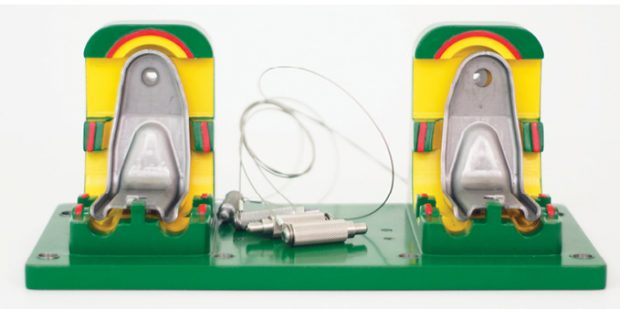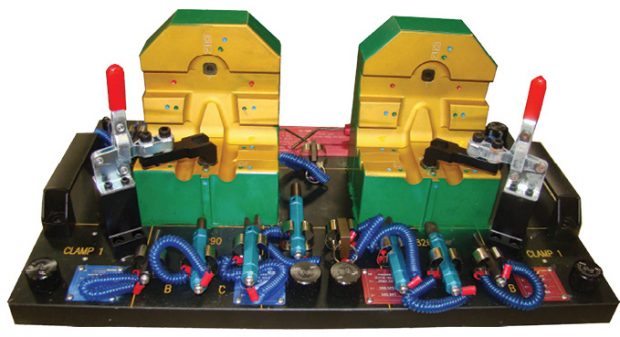Tools, Jigs and 3D Printing: A Lucrative Trio

An original aluminum fixture (top) and a 3D printed iteration (bottom) with clamp-on assemblies. Images courtesy of Stratasys Direct Manufacturing.
Latest News
September 1, 2017
Manufacturing has been through an odyssey of digital transformation in the last decade. 3D printing is part of this transformation, which includes the ability of 3D printing to create tools and jigs that aid in production and assembly within so many industries.
Game Changer
This capability is a game changer, and one that provides a notable boost in design freedom that manufacturers and customers can enjoy.
Pradeep Amladi, global VP of manufacturing marketing solutions for SAP’s manufacturing practice, agrees that 3D printing to create tools and jigs is a boon for manufacturing.
“Creating parts in-house has the potential to reduce inventory and the associated capital significantly and to reduce idle time because there is no wait time for deliveries,” says Amladi. “3D printing allows tool [and] jig manufacturers to move away from reactive or schedule-based service models because digital data can be used to constantly monitor equipment health and predict future failures.”

 An original aluminum fixture (top) and a 3D printed iteration (bottom) with clamp-on assemblies. Images courtesy of Stratasys Direct Manufacturing.
An original aluminum fixture (top) and a 3D printed iteration (bottom) with clamp-on assemblies. Images courtesy of Stratasys Direct Manufacturing.Amladi points out, however, that if production technology changes, as it does with tools and jigs produced via 3D printing, then workflows must also change. “They need tools and processes that can validate and approve or certify parts made via 3D printing from start to finish, modeling through quality assurance,” he says.
Overall, 3D printing’s potential to produce tooling to aid in manufacturing has not yet been fully realized.
Organic Tool Production
“There are a number of excellent materials that can be 3D printed today, including a range of thermoplastics and metals,” says John Kawola, president of Ultimaker North America. “However, materials with special additives and composites can also be extended into 3D printing. These materials often provide enhanced properties that product designers value, such as high strength or reduced weight. The traditional manufacturing processes for using specialty materials or composites is often labor intensive. So, there is potential that 3D printing these materials can be faster and easier than the traditional techniques.”
Ultimaker, a provider of 3D printing technology, worked closely with Volkswagen Autoeuropa several years ago to help them create tools and jigs via 3D printing. Such tools and jigs are produced in-house, rather than by outside vendors. Volkswagen touts its transition to 3D printing as saving the auto manufacturer 91% in tool development costs and reducing development time by 95%.
Automobile manufacturing is not the only application that stands to benefit immensely from tools and jigs produced by 3D printing. The applications are many and include medical and dental products that rely on precision manufacturing and fabrication with very close tolerances. 3D printing enables custom fabrication for patient needs—a common demand and application in the production of medical and dental devices.
“Building such devices through additive manufacturing helps to remove many of the design constraints associated with more traditional manufacturing techniques such as milling, casting or welding and soldering,” says Ed Littlewood, marketing manager of Renishaw’s Medical and Dental Products Division in Gloucestershire, UK.
Littlewood points out that the application of such tools will be well received in any manufacturing application with a high degree of assembly and where there is standardization.
Design Freedom
“Industries that require a large degree of assembly will benefit the most,” Littlewood says. “Jigs and fixtures help reduce labor time and increase quality and precision. There is also a higher degree of standardization—all products are the same—that comes with manufacturers who use jigs and fixtures, and this by itself is a measure of high quality.”
Chuck Alexander is the director of product management for Stratasys Direct Manufacturing in Valencia, CA. He acknowledges that not only will 3D printed fixtures and tools change manufacturing—they already have.
The use of tools and jigs to provide more accuracy and control in assembly and testing can translate into savings of hundreds of thousands each year for firms that embrace it, Alexander says. But he notes it has other tangential benefits, too.
 Stratasys Direct Manufacturing customer MAHLE wanted to consolidate a fixture from three separate components into one part. Based on the part’s parameters, MAHLE was able to use 3D printing to make the fixture a reality. Image courtesy of Stratasys Direct Manufacturing.
Stratasys Direct Manufacturing customer MAHLE wanted to consolidate a fixture from three separate components into one part. Based on the part’s parameters, MAHLE was able to use 3D printing to make the fixture a reality. Image courtesy of Stratasys Direct Manufacturing.“Beyond streamlining production and reducing costs, 3D printing is helping transform manufacturing tools and fixtures because of its design freedom,” he says. “Thanks to the technology’s inherent design freedom, companies can use it to build parts with consolidated features, thereby reducing the total number of components and amount of material necessary to build complex parts.”
Moving forward, design freedom from tools and jigs produced using additive manufacturing and the merit of 3D printing will be huge and part of what Amladi credits to an overarching digital transformation within manufacturing.
“3D printing is just one component of the overall digital transformation in the manufacturing industry and Industry 4.0,” he says. He believes that recognizing its potential and the opportunity it presents is significant for companies that understand what this can do for their operations.
“In order to succeed in this new manufacturing reality, companies must be willing to redefine who they are, what they sell and how they operate,” says Amladi. “Even better are those companies open-minded enough to reevaluate every aspect of operations with an eye toward new, customer-centric innovations.”
More Info
Subscribe to our FREE magazine, FREE email newsletters or both!
Latest News
About the Author
Jim Romeo is a freelance writer based in Chesapeake, VA. Send e-mail about this article to [email protected].
Follow DE





